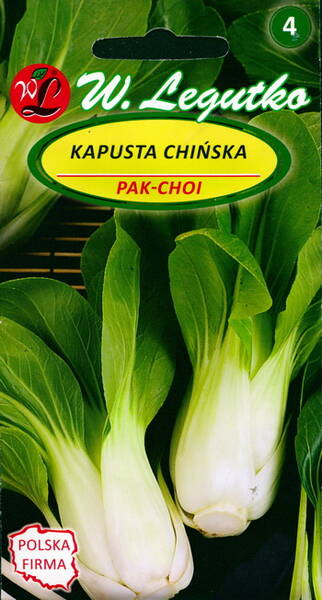Ex Tax: 1.20€
One of the most ancient Chinese vegetable crops.
Pak-choi (paksoy) cabbage is a close relative of Beijing cabbage, but differs from it in appearance, biologically, and also in economic qualities. Although they are completely different, gardeners still constantly confuse them.
One has dark green leaves and bright white petioles, and the other has light green leaves and petioles. Pak choi is much juicier than Chinese, more piquant and spicier in taste. The main difference is its coarser and hairless leaves.
1 gram = 300-400 seeds.
Grow by sowing directly outdoors or by planting seedlings in greenhouse. Leaves and stems are firm, crunchy and it has pleasant, gentile taste. Use fresh and stewed stands cold weather conditions very well and matures in 45-50 days after germination.
* Pak-choi is an early-ripening variety of cabbage that does not form a head. The leaves are collected in a rosette with a diameter of about 30 cm. The petioles are tightly pressed, thick, convex from below, often occupying two-thirds of the mass of the entire plant.
Pak choi stalks are very crispy and taste like spinach. Fresh leaves are used in soups and salads.
Some people call pak choi a salad, but this is not true, as it is a type of cabbage.
In order for pak choy to retain its beneficial properties for a long time, it must be stored following certain rules.
First, separate the leaves from the stalk and rinse them under running water. After that, the leaves must be wrapped in a damp towel, then put in the refrigerator.
Its calorie content is very low, and is only 13 kcal per 100 g of product. The low calorie content is not the only benefit of pak choi, as it is rich in fiber and vegetable fibers.
Fiber is very important in good nutrition, as it not only serves to prevent problems with stools, but also effectively cleanses the intestines of toxins, toxins and cholesterol.
Pak-choi leaves contain a large amount of the most valuable for the human body, vitamin C vessels. Vessels retain strength and elasticity thanks to it. Vitamin C takes an active part in the synthesis of protein, collagen, which allows the skin to remain elastic and elastic longer. 100 g of pak choi leaves contain about 80% of the required daily value of vitamin C.
Cabbage also contains vitamin K, which improves a very important indicator of blood - clotting. The body's daily need for this vitamin can be replenished by eating two hundred grams of pak choi.
It should be noted that if you are taking blood thinning medications, then you should not use pak choi, as vitamin K will nullify the effect of drugs.
Bot. syn.: Brassica antiquorum H.Lev., Brassica campestris subsp. chinensis (L.) Makino, Brassica campestris var. chinensis (L.) T.Ito, Brassica chinensis L., Brassica dubiosa L.H.Bailey, Brassica oleracea var. chinensis (L.) Prain, Brassica rapa var. amplexicaulis Y.Tanaka et Ono, Brassica rapa var. chinensis (L.) Kitam.
* Pak choi stalks contain the most vitamin A (compared to their congeners).
It stimulates the renewal of the skin at the cellular level, and in its absence, the synthesis of rhodopsin, the photosensitive pigment of vision, is not possible. Vitamin A deficiency adversely affects a person's vision and often leads to poor visibility at dusk, which is popularly called "night blindness".
Pak choi cabbage is a very valuable dietary vegetable. It is indicated for diseases of the gastrointestinal tract and the cardiovascular system. Pak-choi cabbage juice has a bactericidal property and retains all biologically active vitamins, minerals and enzymes.
Pak choy is considered an ancient remedy. Its juice has healing properties and is used in the treatment of non-healing ulcers, wounds, burns (the leaves are rubbed on a grater, mixed with raw egg protein and this mixture is applied to wounds).
This vegetable is of great value in the treatment of anemia. Together with cabbage fiber, harmful cholesterol is excreted from the body, and this plays a huge role in the treatment and prevention of atherosclerosis of blood vessels.
Pak choy is used as a dietary component for diseases of the heart and blood vessels.
To maintain good nutrition, it is very good to eat pak choi. It is usually fried with meat, tofu, other vegetables, also steamed, fried in oil or used as a side dish.
Everything in bak choy is edible: both roots and leaves.
It is very easy to clean and cook it: the leaves, separated from the petiole, are chopped, and the petiole itself is cut into small circles.
Paksoy is best consumed as a salad: for this, take bell peppers, freshly grated carrots, grated ginger, dates and pak choy cabbage leaves. Mix all the ingredients and pour over lemon juice, and you can also add sunflower or olive oil (to taste).















